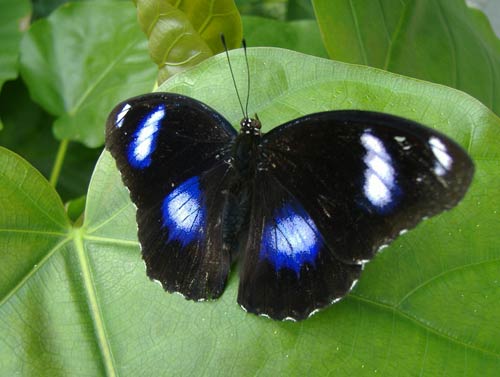Natural selection of butterflies
Danh Phuong
An international team of researchers has documented an unusual example of the natural selection of tropical butterfly species - speaking in terms of genetics - counter-attack against male kill bacteria. highly invasive.
In 10 generations spanning almost a year, the proportion of Hypolimnas bolina male butterflies on Savaii Island - South Pacific - from populations of only 1% jumped to about 39%. The researchers say this is a great return and believe that an increase of a gene that can kill Wolbachia bacteria , which is transmitted from maternal butterflies and only kills butterflies. male before they can hatch.
Sylvain Charlat, the lead author of the study and a postdoctoral researcher, was co-appointed at the University of California, Berkeley, and the University of London said: 'As far as I know, This is the fastest evolutionary change we've ever seen. ' 'This study shows that when a population undergoes extreme selective pressures, as well as a very different sex ratio, evolution can happen very quickly.'
Charlat noted that, unlike mutations to determine features such as the color of the wings or the length of the beard, genetic changes affect the sex ratio of a population. a very broad influence on biological species.

Butterfly Hypolimnas bolina (Photo: wikimedia)
Nor is it a gene that destroys bacteria from a random mutation within the local population, or is it due to the migration of butterflies in Southeast Asia, in which mutations of They are already available.
Charlat said: 'Regardless of whether the destructive gene is derived from the two sources, natural selection will be the next step. The kill gene allows infected female butterflies to produce males, these males will mate with many, many females, and therefore the gene that destroys bacteria is increasingly present in each butterfly. generations.'
Charlat worked with Gregory Hurst, associate professor of evolutionary genetics at the University of London and the final author of the paper. Descriptions of all H. bolina species were after the 1920s, but until 2002, Hurst and colleagues first identified Wolbachia as the culprit behind the this sex ratio difference.
'We often think that natural selection takes place slowly, for hundreds or thousands of years,' says Hurst. 'But the example in this study happened in a blink of an eye, in the form of evolution, and that's an unusual thing to observe.'

Wolbachia (Photo: ualberta.ca)
The researchers note that bacteria that selectively kill male butterflies are found in some arthropod species, so what we see in this study is not unusual, despite the In the past, the literature on science has never been described before. Previous research has uncovered some unusual ways of adapting insects to the pressures inherent when most of its members are of the same breed.
Notably, Charlat and Hurst reported in an earlier study that, thanks to Wolbachia, when H. bolina males, commonly known as Blue Moon or Great Eggfly butterflies, were rare. , the number of mating periods for both males and females increases, which can be considered an attempt to maintain populations, regardless of the difference.
Charlat adds: The relationship between Wolbachia and the Blue Moon butterfly is typical of the so-called Red Queen Principle (Red Queen) , an evolutionary period named after a scene in the famous Lewis book. Carroll, ' Through the Looking-Glass ', in which Alice and the Red Queen character run faster and faster to the top of the hill, only to know that they are still in the same place.
'The key thing is that species must evolve or change to stay in the same place, whether it's a prey's relationship and a predator, or a mutual interaction between signatures. parasites and parasites, ' Charlat said: ' In the case of H. bolina, we are witnessing an arms race about the evolution of parasites and parasites. This further reinforces the notion that parasites may be the main casters of evolution. '
- Butterfly's wicked secret
- Humans are evolving from natural selection to intellectual selection
- Beautiful butterflies
- Extreme evolution to avoid extinction
- How to make a moth into a butterfly?
- History and geography create differences in genes in humans
- February 12: Charles Darwin - Theory of evolution and natural selection
- Butterflies are beautiful like fairytale in Mexico
- Giant butterflies appear much in Soc Trang
- Fluttering because of dozens of butterflies
- Aliens may look like humans
- The point of incredible facts about green butterflies
 Why do potatoes have eyes?
Why do potatoes have eyes? 'Tragedy' the world's largest carnivorous life: Death becomes ... public toilet
'Tragedy' the world's largest carnivorous life: Death becomes ... public toilet Tomatoes were once considered 'poisonous' for 200 years
Tomatoes were once considered 'poisonous' for 200 years Detecting microscopic parasites on human face
Detecting microscopic parasites on human face